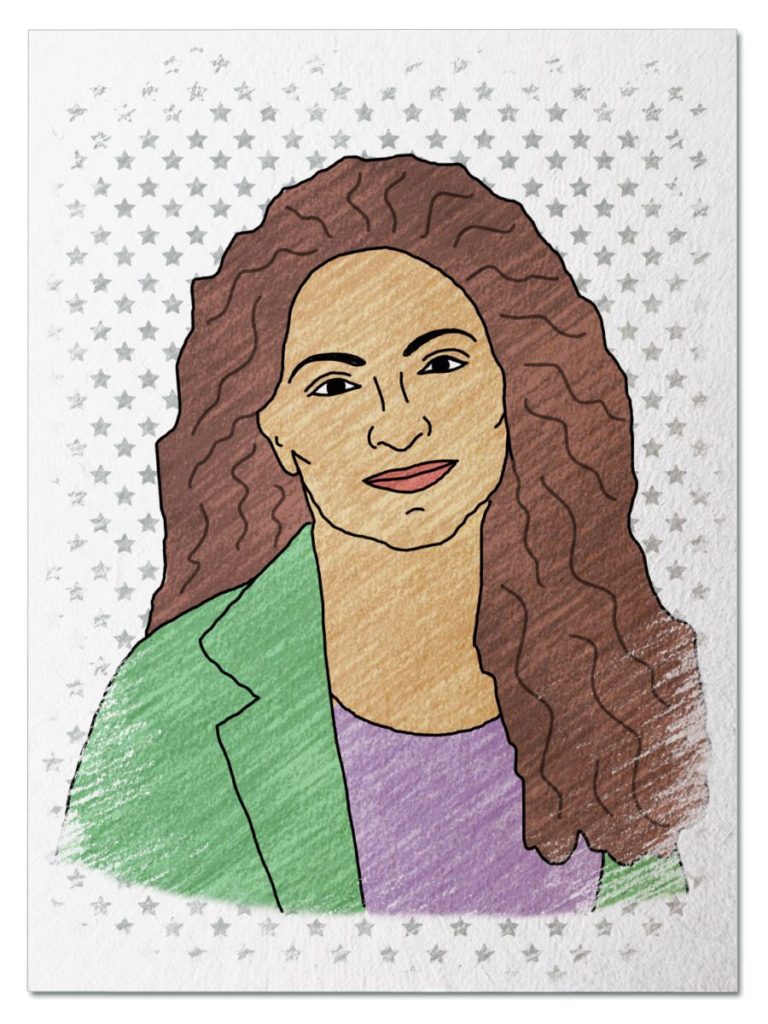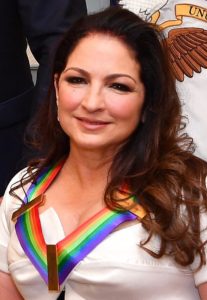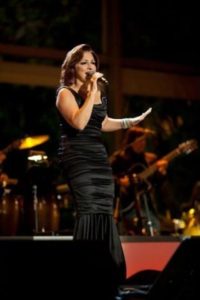Exceptional Entertainer
As a Miami native, she was familiar with the process of cleaning up after hurricanes and tropical storms. But nothing could prepare her for the widespread devastation to the Miami area from Hurricane Andrew. She was determined to use her talents and connections to help her community recover and heal. So she organized a last minute concert and donated all the proceeds to the recovery efforts. Turn the radio dial back to 1992 and listen to international pop star Gloria Estefan’s hurricane relief concert at Joe Robbie Stadium …
Her Ruby Shoe Moment
The Power of the Wand
Her Yellow Brick Road
Brains, Heart & Courage
Glinda’s Gallery
Just the Facts

Her Ruby Shoe Moment
Gloria Estefan sat in the sound proof studio and felt the building shake as a result of the wind. It was August 24, 1992, and Miami was rocked by Hurricane Andrew. After the storm passed, Gloria and her family witnessed the devastation in her community firsthand. Overnight, thousands of people were homeless and lost everything.
 Gloria knew she had to do something. Her fans were there to support her when she needed it. And now it was time to give back. In her words, “I felt a lot of support from my community” after she suffered a broken back in a bus accident. “They gave me a lot of help and determination to come back. I have to be there for them.”
Gloria knew she had to do something. Her fans were there to support her when she needed it. And now it was time to give back. In her words, “I felt a lot of support from my community” after she suffered a broken back in a bus accident. “They gave me a lot of help and determination to come back. I have to be there for them.”
So, Gloria and Emilio turned the parking garage for the offices of Estefan Enterprises into an emergency supply center. It was open to the public and contained items such as bottled water, crutches, clothes, baby food and diapers, and other supplies.
Gloria visited Red Cross shelters and donated money towards relief efforts. But she wanted to do more. So she and Emilio decided to host a benefit concert, with the proceeds benefiting the hurricane relief efforts. And they had three weeks to pull it all together.
The Estefans received a lot of community support — the Joe Robbie Stadium waived its rental fee, stadium staff worked for reduced pay, and profits from food, beverages, and parking were donated as well. Many of the performers, such as Whoopi Goldberg, Jimmy Buffet, and the Bee Gees, donated their time. The concert sold out in days and raised over $1.3 million for hurricane relief efforts.
 A few months later, Gloria announced she would donate all royalties from her single, “Always Tomorrow,” towards the hurricane relief efforts. The song was released worldwide on October 12, 1992, and its video focused on hurricane victims and the rebuilding efforts in Miami.
A few months later, Gloria announced she would donate all royalties from her single, “Always Tomorrow,” towards the hurricane relief efforts. The song was released worldwide on October 12, 1992, and its video focused on hurricane victims and the rebuilding efforts in Miami.
Gloria has continued to help communities over the years, including those devastated by both Hurricane Katrina in 2005 and Hurricane Maria in 2010. For example, she led a group of Latino artists to support the hurricane victims in Louisiana — they filled a plane with supplies and toys and distributed them to shelters along the Louisiana coast.
She participated in a similar effort after Hurricane Maria, bringing a plane filled with supplies to Puerto Rico. In addition, Gloria joined forces with Lin-Manuel Miranda and other Latino artists to record “Almost Like Praying,” the proceeds of which benefitted the victims of Hurricane Maria.
The Power of the Wand
Gloria has lived in Miami most of her life and given back to the community in many ways over the years — boating safety advocacy, youth arts education, the New World Symphony, Miami Project to Cure Paralysis, and Lois Pope LIFE Center. In addition, the Gloria Estefan Foundation provides funding for health and education initiatives in Miami.
Her Yellow Brick Road
Gloria was drawn to the music of her Cuban heritage. At the time, there was virtually no Latin influence in American pop music. Gloria and the Miami Sound Machine brought Latin music into the mainstream with its first album, Primitive Love, in 1985. The band went on to have six Top 10 Hits with 3 years. Eventually, the Miami Sound Machine disbanded and Gloria became known as a solo artist.
 Then, Gloria’s life changed forever on March 20, 1990. She was on her third concert tour and headed to the next venue in Syracuse, New York. The tour bus ran into traffic near Scranton, Pennsylvania — a jackknifed semi-truck had blocked the freeway. While they were stopped, a truck slammed into the back of the bus.
Then, Gloria’s life changed forever on March 20, 1990. She was on her third concert tour and headed to the next venue in Syracuse, New York. The tour bus ran into traffic near Scranton, Pennsylvania — a jackknifed semi-truck had blocked the freeway. While they were stopped, a truck slammed into the back of the bus.
At the time, Gloria was sleeping in a top bunk. Upon impact, she was thrown onto the floor and her spine broke in several places. She couldn’t move and was in excruciating pain.
Emergency medical personnel brought her to the Scranton Community Medical Center, where she was stabilized. But Gloria needed emergency surgery, so she was transferred via helicopter to the Hospital for Joint Diseases Orthopedic Institute in New York City.
Surgeons placed two titanium rods on either side of her spine, to stabilize it and fuse the vertebrae. It was a major surgery with a long recovery. Gloria was in physical therapy for over one year, pushing through the pain and working diligently to reclaim her life.
Gloria wrote the songs for her next album, Into the Light, during her recovery. In fact, the love and support she received from fans was part of her inspiration. And she went back on tour within 2 years after her accident.
Brains, Heart & Courage
Gloria was a Cuban refugee who grew up in Miami. She came to America when she was two years old — her family was forced to flee when Fidel Castro came to power, since her father had been a police officer and bodyguard for the former first lady of Cuba. They were part of a thriving Cuban community in Miami, but longed to return to Cuba one day.
While growing up, Gloria learned firsthand about sacrifice and service, as well as perseverance and resilience. Her father never stopped fighting for a free Cuba and participated in the Bay of Pigs Invasion in 1961. He was captured after the invasion failed and spent the next two years in a Cuban prison, before being released as part of a prisoner exchange.
 A few years later, her father enlisted to serve in the Vietnam War, where he suffered chemical exposure from Agent Orange and became very ill. He was eventually diagnosed with Multiple Sclerosis and became wheelchair bound. And Gloria spent much of her adolescent years helping to care for him.
A few years later, her father enlisted to serve in the Vietnam War, where he suffered chemical exposure from Agent Orange and became very ill. He was eventually diagnosed with Multiple Sclerosis and became wheelchair bound. And Gloria spent much of her adolescent years helping to care for him.
Gloria’s childhood was filled with music, including Cuban music at home and hymns in the church choir. She also performed duets with her cousin, Mercedes.
She met Emilio Estevan and the band, Miami Latin Boys, when they all sang at the same wedding in 1975 — Gloria and Mercedes sang an impromptu Cuban song. Emilio was impressed with her voice and asked her to join the band. Before long, Gloria became the lead singer and they changed the name to the Miami Sound Machine.
When Gloria joined the Miami Sound Machine, she was 20 years old and a college student at the University of Miami. She was determined to continue her studies and graduate, so the band held rehearsals in the evening. Most of their bookings were weddings, bat mitzvahs and quinceañeras on the weekends.
At first, the Miami Sound Machine focused on original Spanish language songs. In fact, their music was more popular in South America than in the United States. Then, the band recorded its first studio album with Columbia Records in English. And everything changed.
Glinda’s Gallery
Just the Facts
- Gloria María Milagrosa Fajardo García Montaño y Pérez was born on September 1, 1957 in Havana, Cuba. After the Cuban Revolution of 1959, she and her family escaped to America as refugees.
- Gloria became a naturalized citizen in 1974 as Gloria Garcia Fajardo.
- Gloria attended Our Lady of Lourdes Academy during high school, then graduated with a BA in psychology from the University of Miami in 1979.
- Gloria and Emilio married in 1978 and have two children, Nayib and Emily.
- From 1985-1990, Gloria and the Miami Sound machine had over nine Top 100 hits, including “Rhythm is Going to Get You,” “1-2-3,” “Get on Your Feet,” and “Conga!” She sang at the 1996 Olympic Games and the 1998 Super Bowl halftime show.
- Gloria also released at least 4 Spanish-language albums — Mi Terra won the Grammy for Best Tropical Latin Album in 1993. And she was the first artist to perform a song in Spanish at the 1995 Grammy Awards.
- Gloria has won 7 Grammy Awards, BMI Songwriter of the Year Award, MTV Video Music Award, Award of Merit at the American Music Awards, and is listed in Billboard Magazine’s Top 100 Best Selling Musical Artists. She and Emilio were also inducted into the Songwriters Hall of Fame at the National Academy of Popular Music.
- Gloria has also received the International Women’s Forum “Hall of Fame” Award, Congressional Hispanic Caucus Institute’s 2001 Medallion of Excellence for Community Service, the Presidential Medal of Freedom in 2015, and the Kennedy Center Honor award in 2017.
- Gloria wrote 2 children’s books: The Magically Mysterious Adventures of Noelle the Bulldog (2005) and Noelle’s Treasure Tale (2006).
Want to Know More?
The Gloria Estefan Foundation (http://www.gloriaestefanfoundation.com)
Gloria Estefan website (http://www.gloriaestefan.com/index.html)
Gloria Estefan, Florida Artists Hall of Fame (https://dos.myflorida.com/cultural/programs/florida-artists-hall-of-fame/gloria-estefan/)
Gloria Estefan – Artist, Grammy Awards (https://www.grammy.com/grammys/artists/gloria-estefan/2518)
“President Obama Names Recipients of the Presidential Medal of Freedom,” The Office of Press Secretary, The White House, November 16, 2015 (https://obamawhitehouse.archives.gov/the-press-office/2015/11/16/president-obama-names-recipients-presidential-medal-freedom)
Phillips, Jane. Gloria Estefan. Broomall, PA : Chelsea House Publishers, 2001.
